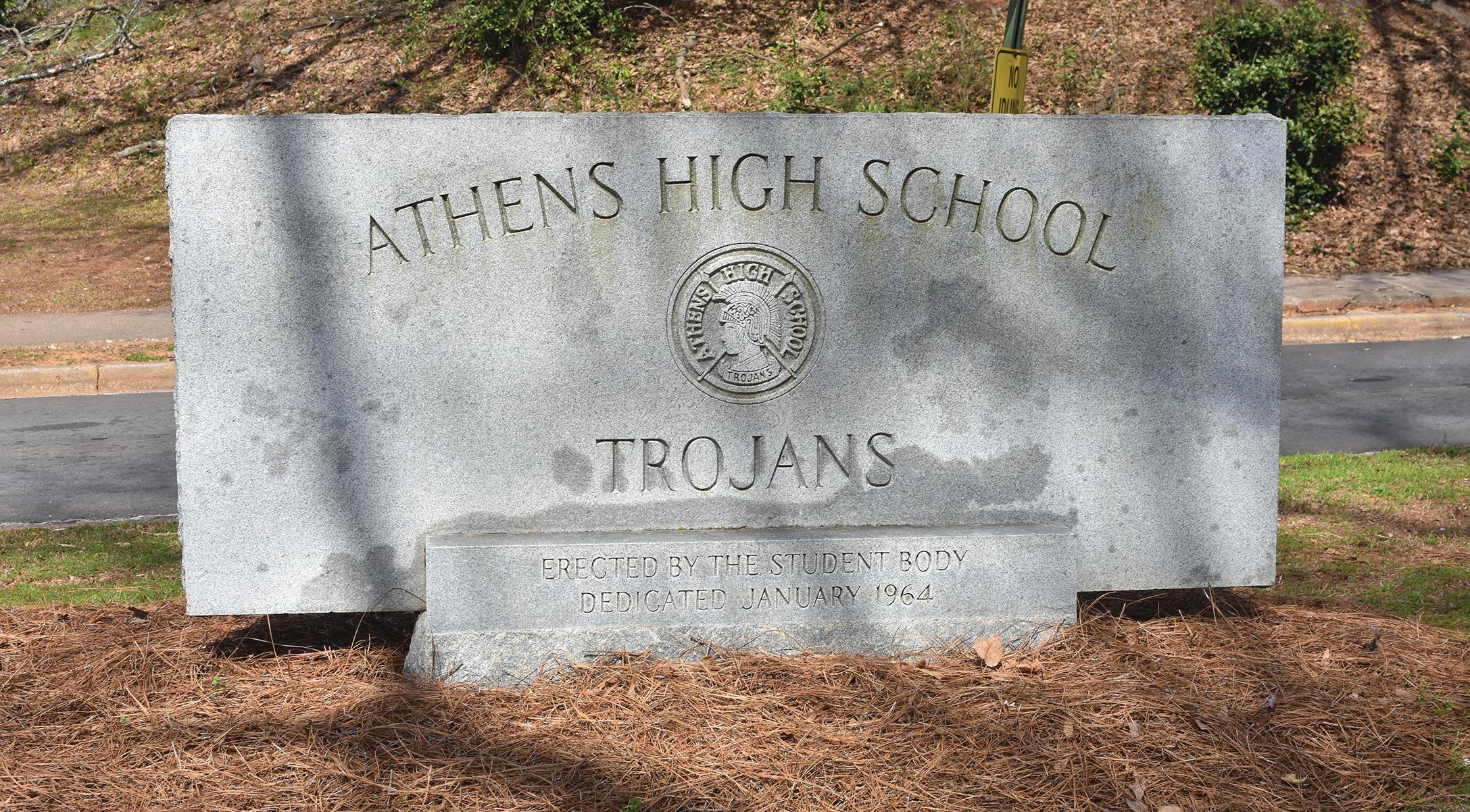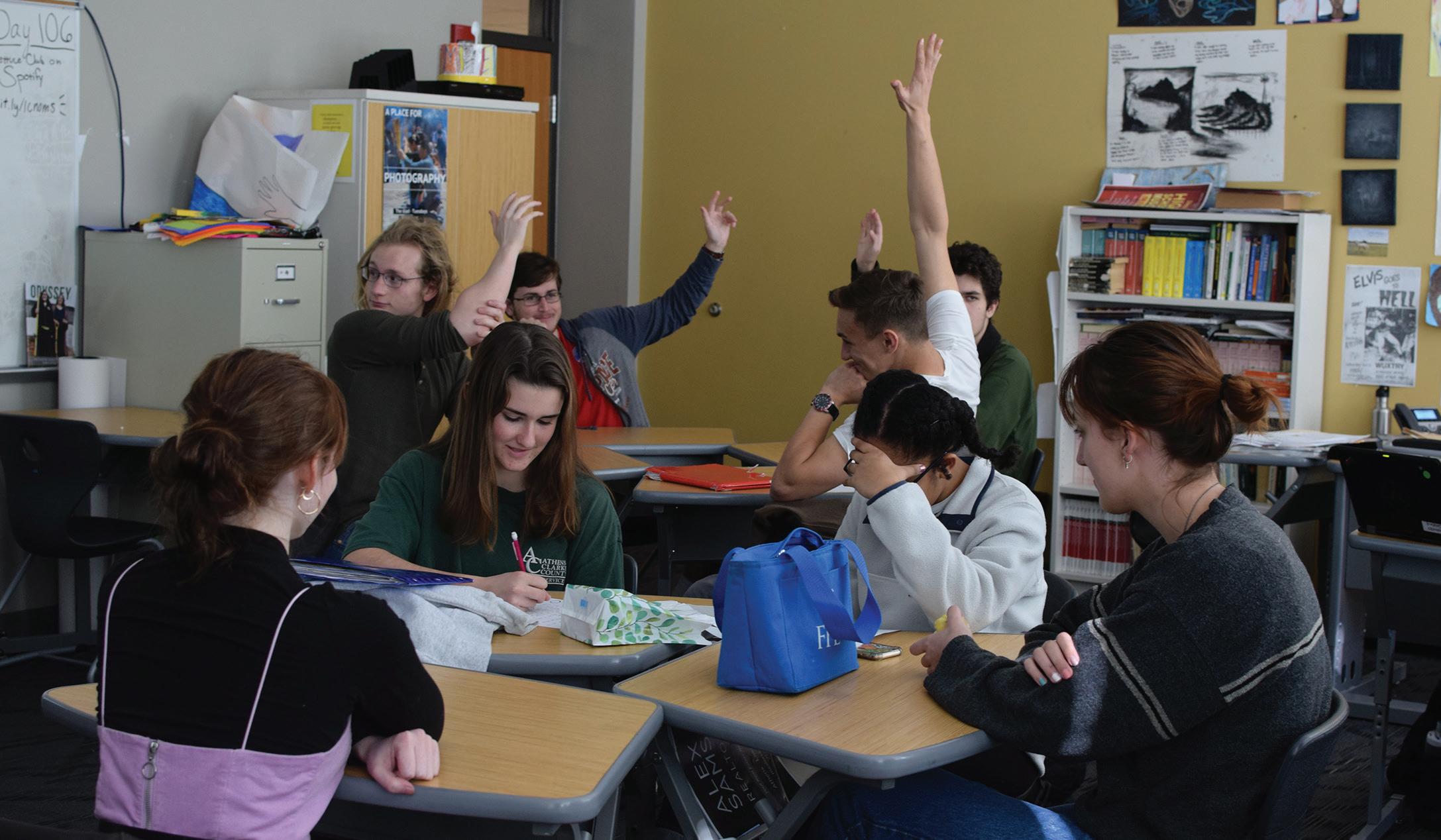
21 minute read
Engaging with gender
Above: GENDER DISCREPANCIES: Male students raise their hands in a staged photo at Clarke Central High School. Male and female students are often treated differently in the classroom, which can lead to differences in how students feel expected to behave. “High school is really where you solidify some kind of idea for what you want to do with the rest of your life, and it’s where your personality really starts to form,” CCHS senior and Women in STEM president Maggie DeMaria said. “If you’re always taught, ‘No, don’t talk in class’, (or that) you’re supposed to be the weak one, you’re not gonna go out and do the things that you want to do.” Photo by Naomi Hendershot Right: NEGLECTING GIRLS: A male student raises his hand while a female student sits quietly in a staged photo. Female students are often conditioned to be less confident or assertive than their male counterparts. “We’re socialized to be polite, to be nice, to play down our brilliance, our intelligence, and to stay in our place,” University of Georgia Institute for Women’s Studies Director Dr. Juanita Johnson-Bailey said. Photo by Naomi Hendershot
At Clarke Central High School and around the nation, differences between how male and female students are taught and engage in class can cause female students to have
Advertisement
A poll of the Clarke Central High School student body conducted by the ODYSSEY Media Group showed that 85.9% of students believed that there was either “some” or a “large” difference between the way male and female students behave in the classroom. According to the article “Gender Differences in the Classroom” from Educational Psychology, teachers interact 10 to 30% more with male students than female students.
University of Georgia Institute for Women’s Studies Director Dr. Juanita Johnson-Bailey believes that the way students of different genders are treated in the classroom can have long-term effects on their behavior. As a result, although the average female student has greater academic success than the average male student, the differences between how teachers interact with them can cause female students to participate less in classes and have a lack of confidence. less confidence. BY NATALIE SCHLIEKELMAN News Staffer “If you just look across the research, women students tend to have higher GPAs, (and) they tend to have a higher rate of graduation,” Johnson-Bailey said. “But what I have found is that overall women students tend to speak less, to speak less affirmatively, even to write less authoritatively. Men tend to speak and write in a declarative way. Women tend to be more hesitant in the way that they write and in the way that they speak.”
CCHS senior and Women in STEM co-president Maggie DeMaria believes that these differences can also be seen in classrooms at CCHS.
“There is this idea that guys are supposed to be the talkative ones. They’re supposed to be the ones that get up and do the math on the board, and the girls are supposed to sit back,” DeMaria said. “That’s the way that the world has said that women are supposed to behave, (and) that’s what ends up happening because it’s so culturally ingrained.”
According to CCHS Assistant Principal Summer Smith, a former CCHS math department teacher, it can be easy for teachers to accidentally neglect female students in the classroom.
“You tend to find yourself getting pulled to the voices that are louder, and sometimes that could be more male,” Smith said. “I think (the disparity) starts at upper elementary and middle school, and it has to do with girls seeking approval and not wanting to be too smart, or too whatever, if you’re in a situation that doesn’t honor smart female people. (Teachers) have to watch out for girls and not let them downplay (their intelligence) to try to be cute for whoever.”
According to Johnson-Bailey, another way teachers may contribute to gender-related differences in the classroom is through perpetuating the “learned helplessness” effect.
“What learned helplessness means is that, when a young girl can’t solve a problem, we step in (and) help her,” Johnson-Bailey said. “But when a boy has a problem, we say, ‘Oh, you can solve that. Just give it another try. Just keep on going.’ So we’re actually
--Maggie demaria, CCHS senior and Women in STEM co-President programming the boys to be active in their own lives, and we’re programming young girls to reach out for help, to not act in their own lives.”
CCHS junior Ietta Veeder, a member of Strong Girls, an organization that aims to empower girls, believes that differences in classroom behavior rely more on a student’s background than their gender.
“I think it really depends on the individual themself, and how their home life has been, how they’ve grown up, and then the people they’ve placed around them,” Veeder said. “Sometimes there’s a stigma that goes with male versus female, (that) females are more organized and responsible, and for the male, they’re more relaxed and go with the flow. I don’t think that’s true for all males and females within the classroom.”
In CCHS foreign language department Erica Schwartz’s classroom, she says it’s female students who are more active in class.
“(Behavior) is not always (the same) for all males versus females, but more often, it seems like guys are a little bit more reserved about seeming excited about a topic,” Schwartz said. “I think maybe sometimes guys don’t want to be seen as uncool for being into school versus I don’t think that’s something that girls worry about as much.”
CCHS sophomore Alexandra Navas believes that the pressures of class participation can cause low confidence among female students.
“(If a girl gets a question wrong or is shy), I know some people think, ‘Oh, she must be dumb or something like that,’” Navas said. “Then that person might be scared to ask questions more and then could start being (less) social, which could have a big impact later in life because you really need to work on your social life to get good jobs and to just survive.” The contrast in behavior and participation doesn’t stop when a student leaves the classroom. According to Johnson-Bailey, the differences can affect how people behave in the workplace.
“(These messages about how we’re supposed to behave) follow us throughout the workplace,” Johnson-Bailey said. “We have to do salary adjustments every few years because women salaries tend to lag behind, even if they have had the same accomplishments as men, because we’re not taught to negotiate. We are encouraged not to negotiate when it comes to salary and when it comes to knowing our worth.” CCHS math department teacher Wilkery Jeanty has also observed that the way students conduct themselves in high school often affects their behavior later in life.
“I think from what I’ve seen (as students mature and become adults) they can be directly affected by their behavior in high school,” Jeanty said. “Their behavior can change, but with most people that does not change. From high school to colleges or in the workplace, (it) is gonna be about the same.” Johnson-Bailey believes that one of the best ways to help female students gain confidence and assertiveness is by providing them with positive motivators.
“We all, as women (and) as girls, have a responsibility to believe in ourselves and to try to live our best lives, but I think that a lot of times it’s hard to do it alone,” Johnson-Bailey said. “I think that’s why it’s so important to have positive messages for young girls in the media and (from) any organizations that they’re exposed to, such as family and school (or) church or the clubs that they’re members of. We have to put those positive messages out there.”
Veeder agrees that community mindsets, where girls can support each other and place emphasis on achievement, can be extremely helpful for female students.
“You become more confident in your actions and with risks, and you’d be more comfortable helping the student beside you with their class work. You’d be more comfortable around the group that you’re with, so in the classroom you could excel better,” Veeder said.
According to DeMaria, the Women in STEM club aims to create an accepting environment for members, as well as for the rest of the student body.
“(What) Women in STEM tries to do is to create a community of high achieving, high aspiring girls. We (can) continue to foster that community and make sure that there’s a community of
people supporting each other,” DeMaria said.
From Smith’s perspective, creating an empowering environment throughout CCHS is an important next step towards gender equity. “One of the things I like about Clarke
County is that I feel like intelligence is
honored, whether it is male or female,” Smith said. “(It needs to be all about) honoring excellence and achievement, whether it’s male or female, and providing safe spaces for people to be smart and to be who they are. (We need) to applaud efforts and keep watch for the people who might be falling off the radar. Just (helping) girls feel more confident.” O
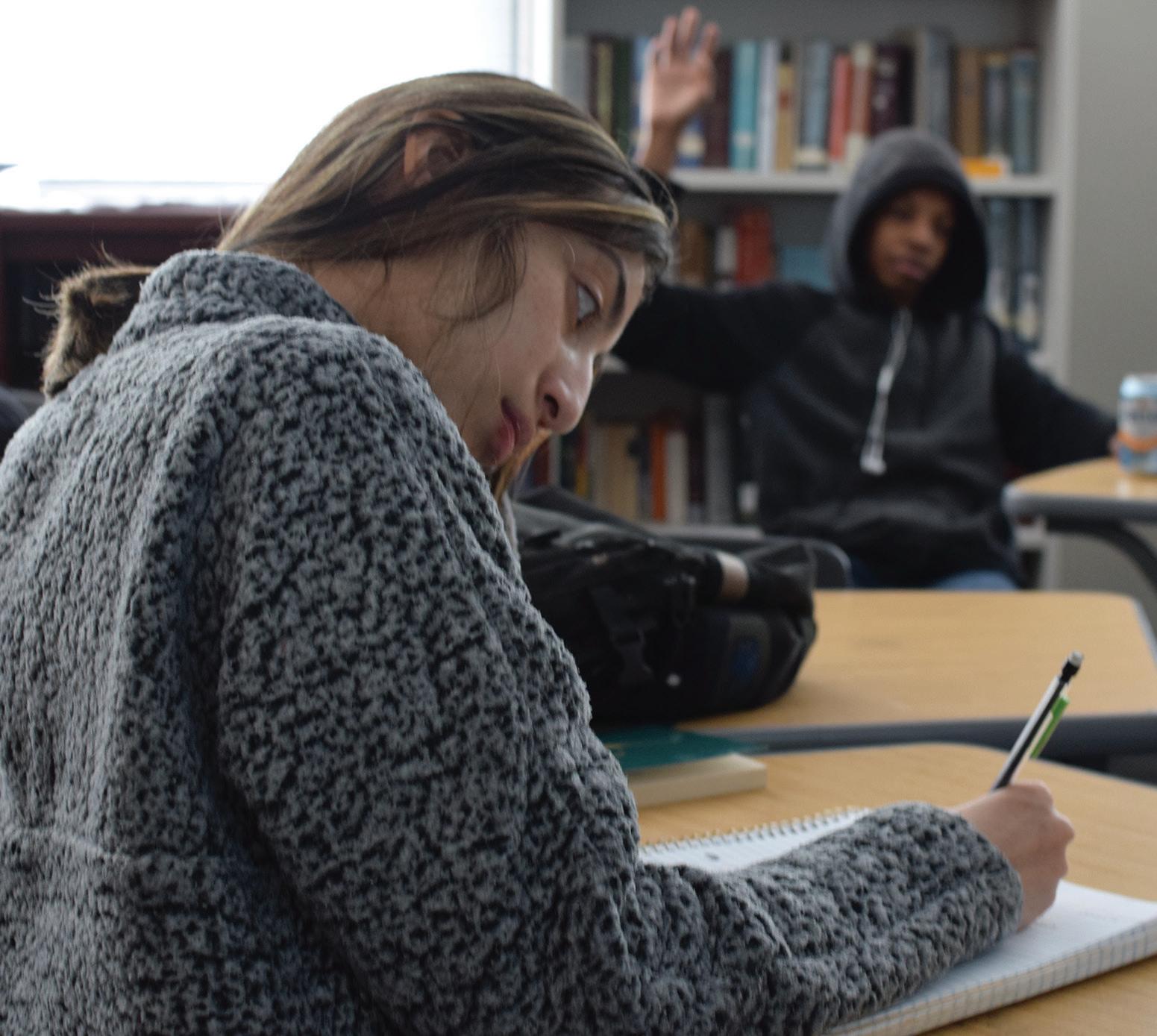
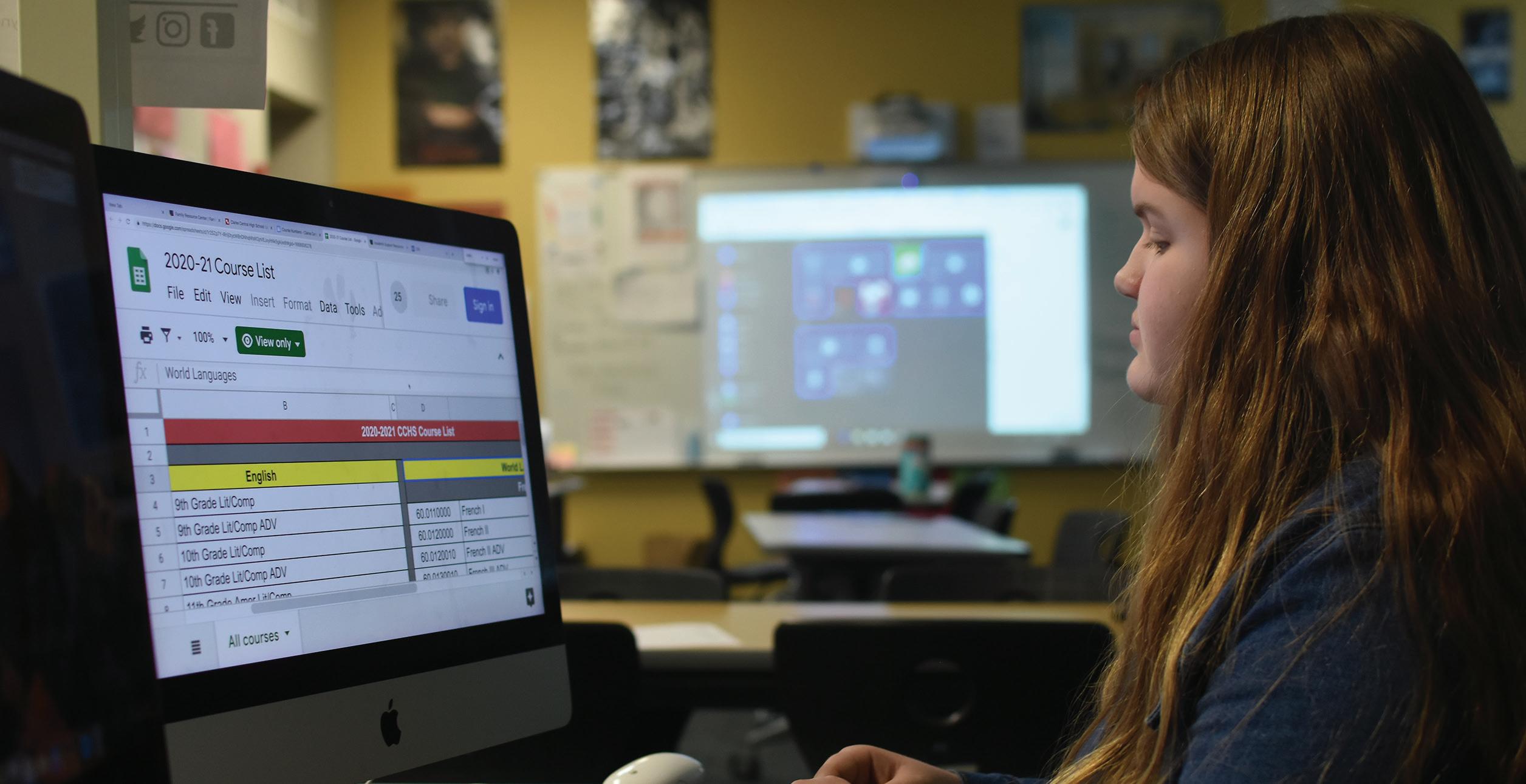
Above: OPTIONS: Clarke Central High School sophomore Julia Lane looks at new course options for the 2020-21 school year. Lane took the Intro to Guitar class this school year and is thankful that she had that option. “I’ve always wanted to learn how to play (guitar), but I’ve never had a guitar, I’ve never been able to take lessons really, and so it’s like a free class,” Lane said. “(I’m) pretty beginner (at guitar), so I’ve gotten a lot better. I didn’t know anything at the beginning of the year.” Photo by Krista Shumaker
Classes at Central
An expanded course catalog will be available to Clarke Central High School students for the 2020-21 school year.
There are 14 new classes being considered for Clarke Central High School in the 2020-21 school year, according to CCHS Assistant Principal Summer Smith. These potential new classes include Introduction to Women’s Literature, Ethnic Studies, Contemporary Literature/Composition, Business and Technology, Business and Communications, SAT preparation, Audio Video Tech & Film I, AP Spanish Literature and Culture and additional levels to a number of other courses.
“I put a lot (of classes) out there, but if it makes or not depends on whether the class will actually happen, and so we have to have enough interest,” Smith said. “If enough people don’t sign up for it, we wouldn’t offer it.”
Teachers who want to start a new class generally bring the idea to their department chair, who then proposes the class to Smith.
“I usually go to the department chairs and I’m like, ‘Hey, is there something that somebody in your department wants to offer?’ For instance, the African American History (class), there’s a social studies teacher who’s interested in it. She has to go to her department chairs, have a conversation BY ISABELLA JOHNSON News Staffer
and then come to me and we put it on the list. Then I basically have to ask if it can be added to the program of study, and (it has to be) approved by the (Clarke County School District Board of Education),” Smith said.
The switch to block schedule for the 2020-21 school year will give students the opportunity for an additional class per year, which has created a need for more classes.
“The biggest struggle for us is what can we add given our space confinements. We need things that kids can take that aren’t interested in journalism; (journalism students fill up their) schedule with journalism, band kids fill up their schedule with band, drama kids go to drama. But what about the kid who’s just kind of like, ‘Eh, I don’t care about that stuff ’?” Smith said.
CCHS science department teacher Claude Gonzalez started a Zoology class last year and believes that, if the course is approved by the Board of Education, adding a variety of elective classes to the schedule is a fairly simple process.
“There’s a lot of flexibility in getting (new courses) approved and doing it for the school year,” Gonzalez said. “Last year, (the science co-chairs and I) decided we needed a fourth science for the
News kids who are not on the chemistry/physics track. I volunteered to do Zoology, which is a class that we used to have around here but haven’t had in years. There was that need (for) the fourth science, and so I was willing to do the work of putting together a curriculum for it.”
CCHS sophomore Julia Lane took the Intro to Guitar class this year and feels that a new level would allow her to keep up the skills she’s learning now.
“I didn’t know anything at the beginning of the year, so I’ve gotten a lot better,” Lane said. “If there wasn’t a higher (level), I might not want to take (guitar again) cause it would kind of be the same thing. (It’s important for students) to have more options to take higher classes.”
These new levels and new courses will all have to adjust to the new time frame that their classes will be operating on.
“You can’t stand up on block (schedule) for an hour and a half and just talk at kids, and you also can’t just teach for an hour and then say 30 minutes of homework time,” Smith said. “Teachers are gonna have to learn how to adapt how they teach so that there’s some teaching and some doing by students. That takes students a little bit to get used to.” O
Featured: PROTEST AT THE PARADE: On Jan. 20, members of the Athens community gathered Downtown for the annual Martin Luther King Jr. Parade. Member of Indivisible Georgia District 10 Jacqueline Elsner attended the parade in order to register voters. “We figured there would be lots of citizens from more than just Clarke County, and our goal is to register as many voters as we can for 2020,” Elsner said. “We’re just looking for locations when a lot of citizens are gathering and we can contact them -- that’s why we chose to come today.” Photo by Elena Gilbertson Hall

EchoEs of integration
The desegregation of the Clarke County School District affects the educational experiences of students in the district both socially and academically to this day.
The Clarke County School District took its first steps toward an integrated educational system by selecting five Black students to attend the all-White Athens High School in 1963, 11 years after the Supreme Court case Brown v. Board of Education (1954) ruled racial segregation in schools unconstitutional.
Community member Linda Davis began attend- ing the previously all-White Clarke Junior High School, now Clarke Middle School, among the group of students who exercised their freedom of choice to desegregate the district in the late 1960s. “My mom explained to me that we were working to help desegregate the schools and improve education for everybody in Clarke County,” Davis said. “We were (recommended), which is what probably sold us on it, because we were academ- ically doing well. (CCSD) wanted to make sure that, in this desegregation effort, there was no doubt that Black people can learn.” For Davis, entering an allWhite school was a drastic change from her previous experiences at segregated schools and required much preparation.
“We were taught about nonviolence. We were taught to ignore the taunts. We were taught to ignore the stares, to ignore anything that anybody did to us because we were warned that it was not going to be easy, and it may not be pleasant, but we were there for a purpose,” Davis said.
The next year, Davis entered AHS, where the large number of majority-White clubs and sports diminished her participation in such activities. BY AUDREY ENGHAUSER Menu Editor “There was nothing to give us a sense of be- longing. We weren’t welcome in a lot of the clubs when we desegregated these schools,” Davis said. “Leaving campus every day, we made a beeline over to (Burney-Harris High School) because we wanted to be with people that look like us, that liked us and that treated us like we were normal people.” Community member Barbara Archibald, a current CCSD substitute teacher, attended the all-Black Athens High and Industrial School, renamed BHHS in 1964, throughout the district’s desegregation. According to Archibald, the students at her school were at an academic disadvantage.
“We lacked so many things in terms of material resources that would have helped us probably to accomplish a little bit more academically,” Archibald said. “The books, for example, were used and torn, and they were given to us after they have been
used by students at AHS.”
Despite this discrepancy, Archibald feels that she received a quality education and was motivated to succeed by the school’s faculty.
“The principals would get on the intercom in the mornings and talk about (how) you were important, what you need to be doing, how education was important (and) it was the key to our success,” Archibald said. “(Segregated schools) instilled in us different values that would help us be successful in this world.”
Community member Barbara Barnett transferred from BHHS to begin attending AHS in 1965 and found it difficult to participate in the new environment.
“It wasn’t easy because we were not wanted, we were not accepted,” Barnett said. “We didn’t have “There was nothing to give us a sense of belonging.”
--LINDA DAVIS, community member
Featured: ONE OF FEW: Community member Fannie Smith sits in front of the Clarke Central High School on Feb. 10. Smith attended the all-White Athens High School from 1964 to 1968 before it was fully desegregated in 1970 as one of few Black students. “I experienced basically isolation and not being a part of anything,” Smith said. “Maybe there was a couple of (Black students around me), two or three or four of them, but it was a really small number. Most of my classes were still basically White.” Photo by Audrey Enghauser
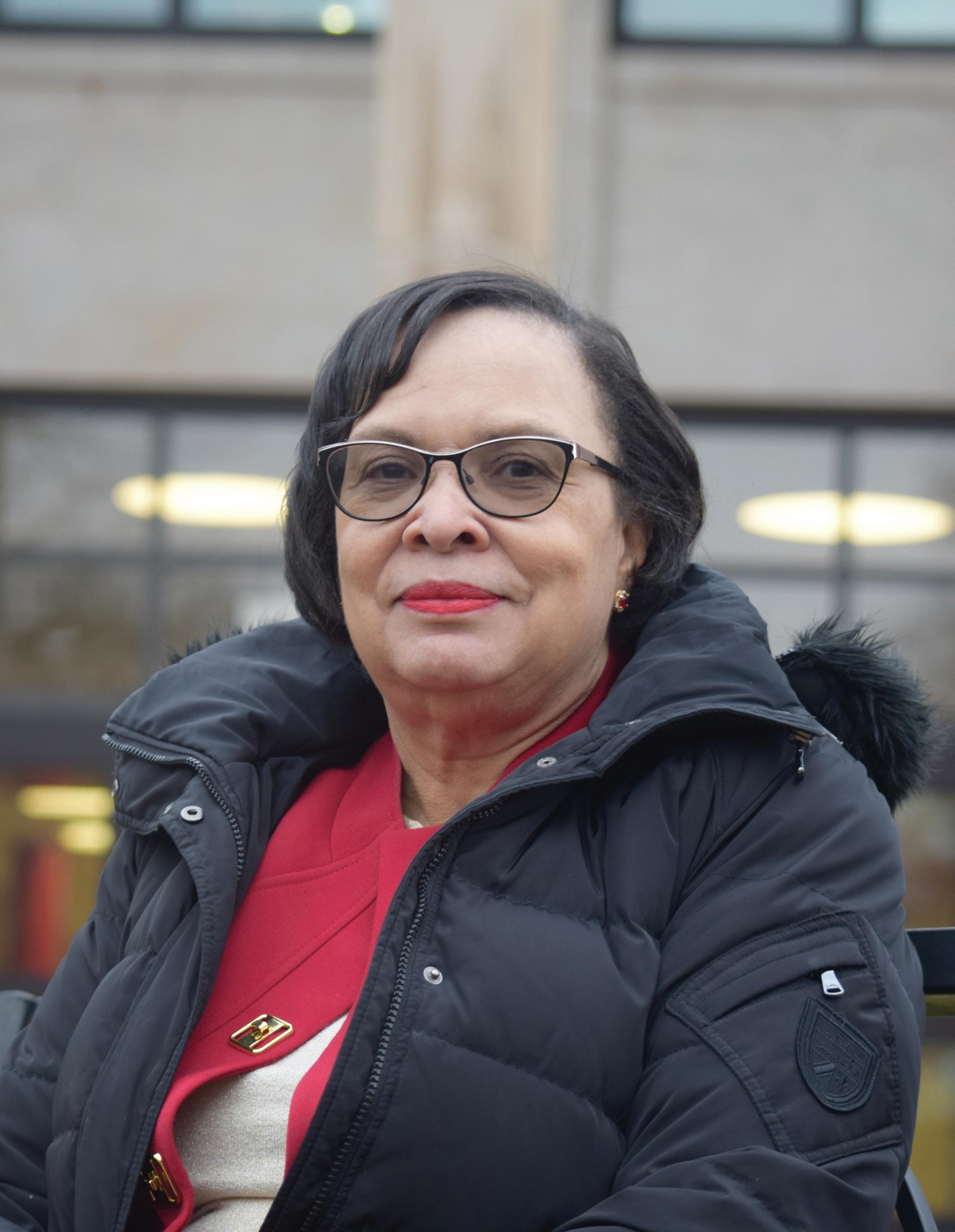
you really felt is that you were totally isolated. Once you went out of the classroom, you’re on your own, and if you went to lunch, you were on your own. It’s like you’re on an island by yourself,” Smith said. CCSD employed freedom of choice for Black students in the late 1960s, leaving it up to families to decide which school their children should attend. For Smith, a noticeable difference in newly desegregated schools was the lack of a familiar community.
“Mr. (H.T) Edwards, who was the principal of (AHIS/BHHS), was our organist at church, so you

--Camille Thomas, CCHS junior
Above: ALONE AT AHS: A portion of the senior class at Athens High School is pictured in the 1968 Athens High School yearbook, “The Trojan.” Community member Fannie Smith (bottom row, third from left) was one of 20 Black students to graduate from the newly integrated high school. “You could feel fearful of White people, but (violence) really didn’t happen. You can feel that people just act like you either don’t exist, or you’re a little troubled, but they’re not gonna say anything to you,” Smith said. “(Nevertheless), I could survive by myself. I didn’t need (everyone) to be my friend to survive and to achieve in school.” Photo courtesy of the 1968 Gladius
--Fannie Smith, community member
the opportunity to just enjoy high school, because we were struggling with the segregation, and we were struggling with not being accepted and not wanted in the school by the students or some of the teachers.” Barnett was one of 20 Black students to graduate AHS in 1968, alongside community member Fannie Smith. “The only (thing) saw him in two roles. Most of my Sunday school teachers were teachers in the school district. Some of the neighbors would teach,” Smith said. “Now you’re in the (integrated classroom), you don’t know any of these people, and so it doesn’t feel the same.”
Despite the growing integration of Black students into AHS, the school’s faculty failed to reflect similar demographic changes.
“I have seen our shift in who’s in charge of the classrooms go from the all-Black experience to a completely White experience (at AHS),” Davis said. “I didn’t have a single Black teacher until I got to high school, (and I had) Mrs. Ruth Hawk Payne, she was my Spanish teacher. That was the first other Black person in authority that I saw once I left the segregated school system,” Davis said.
In 1970, students from AHS and BHHS began attending the new Clarke Central High School, previously AHS, and the new Cedar Shoals High School, according to their respective school zone. In Archibald’s experience as a substitute teacher at CCHS, the racial atmosphere of the school has improved over time.
“Socially, I don’t see where (Black and White) kids have a problem with each other. I don’t see that. It seems as if, from the classes that I have that I sub (for), it’s an integrated setting,” Archibald said. While the CCSD educational system has not been segregated in over 57 years, CCHS junior Camille Thomas notices this history impacting her daily life at CCHS in the form of self-segregation amongst her peers.
--Barbara Barnett, community member “In (Advanced Placement) classes, I’m the only one that looks like me. Not that (White students) don’t include me, but sometimes I don’t (include) myself. That’s where I notice (self-segregation) most,” Thomas said. “Teachers try (to counteract self-segregation) with the assigned seats and everything, but you always end up back with people who you’re most comfortable with.”
CCHS Associate Principal Dr. Linda Boza has noticed some students taking action on this issue in the past but has yet to see a sustainable resolution.
“We had a group of students (that) would do ‘Mix-It-Up Day’ in the lunchroom, to try to get students to sit with people they don’t normally sit with, because they recognized (self-segregation) and they wanted to change the mindset,” Boza said. “We haven’t done it in a few years now, but it was a great thing that we had going, because when students realize it and take action, that’s really what it takes.”
According to Smith, while she taught at Burney Harris Lyons Middle School from 1995 to 2011, the school’s racial demographics shifted, becoming majority-Black over time due to White flight. “(White people) were moving to Oconee County, and they were sending their kids to private or religious school. At that time, some people would say later on that there’s a lot of stuff going on in schools, there’s violence and stuff, but that wasn’t true. Kids were wonderfully behaved,” Smith said. “Those were not the issues, but people really decided they didn’t want their kids to participate, being that kind of school. The (White) population basically never came back.”
According to Barnett, the students and faculty of CCSD have taken steps toward overcoming the district’s history of segregation in recent years.
“A lot of people have learned about segregation. A lot of people have changed their mind. They have changed the way they felt (through) education (and by) getting to know people,” Barnett said. “(People started) respecting each other a little bit more, and it made a big difference. They accepted the fact that integration is here, and it’s here to stay.”
According to The Governor’s Office of Student Achievement, CCHS now has a White population of 23%, while Black students make up 46% of the student body. Thomas believes such diversity is beneficial for students.
“Being able to think outside of what you’re used to is an advantage. It teaches you a lot of life lessons, a lot of things you need to know (in) college, adult life, everything,” Thomas said. “If you’re used to the same kind of people with the same kind of mindset, you’re not going to be ready for the real world.”
Within 60 years, Barnett’s family has seen three generations of children attend AHS/CCHS, each of which have witnessed the district at various states of integration and diversity. She believes these racial changes will continue to benefit school communities in CCSD.
“I remember sitting in there at the (UGA) Coliseum (at my granddaughter’s graduation), looking at all the Black students coming through and then thinking, ‘Wow, I never thought I’d see this.’ It was more Blacks than Whites. I remember having a little satisfaction in knowing that I helped tear down those segregation walls so others, my children and other Black students, could come through easily, and not go through what we went through,” Barnett said. “It was not an easy task, but it is one that I’m glad I was a part of.” O
